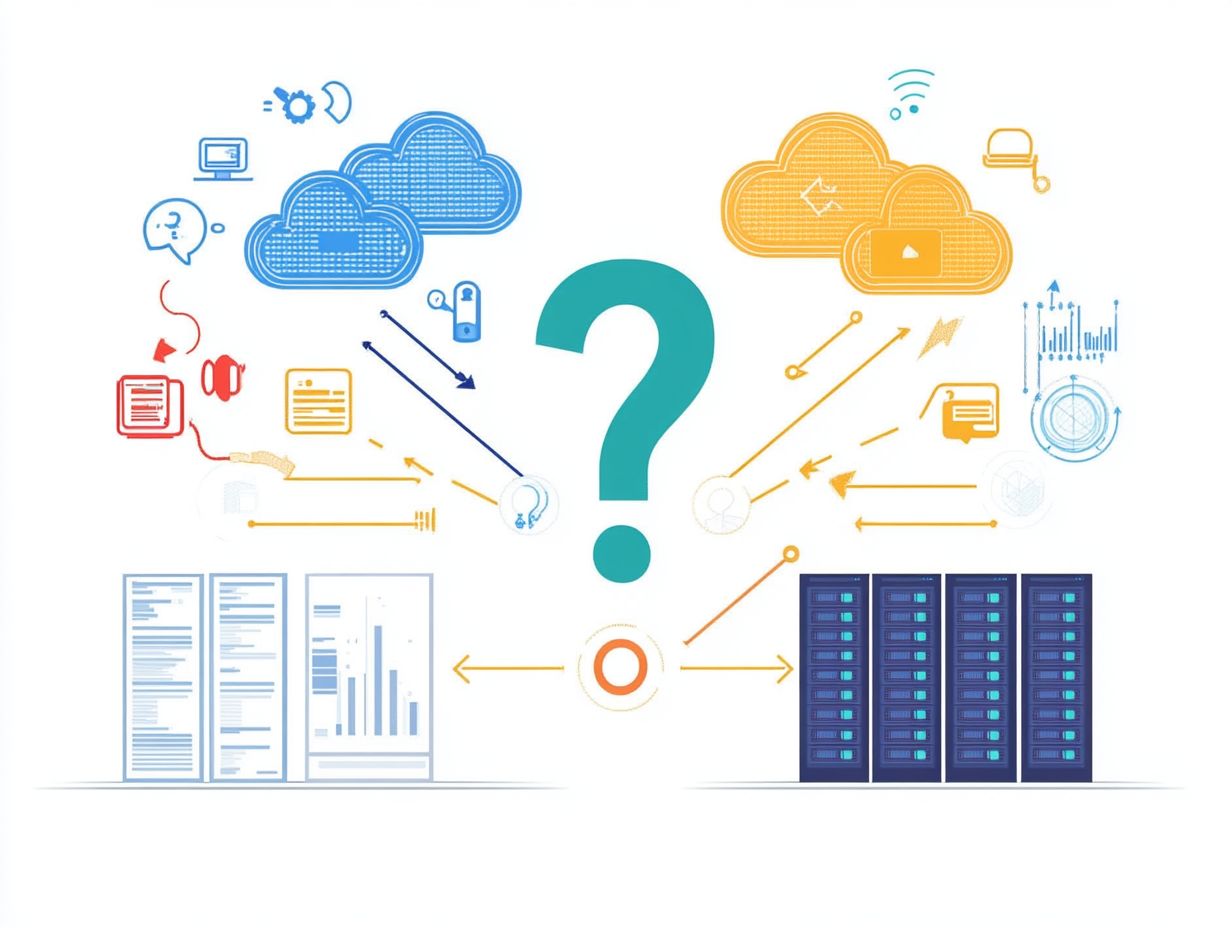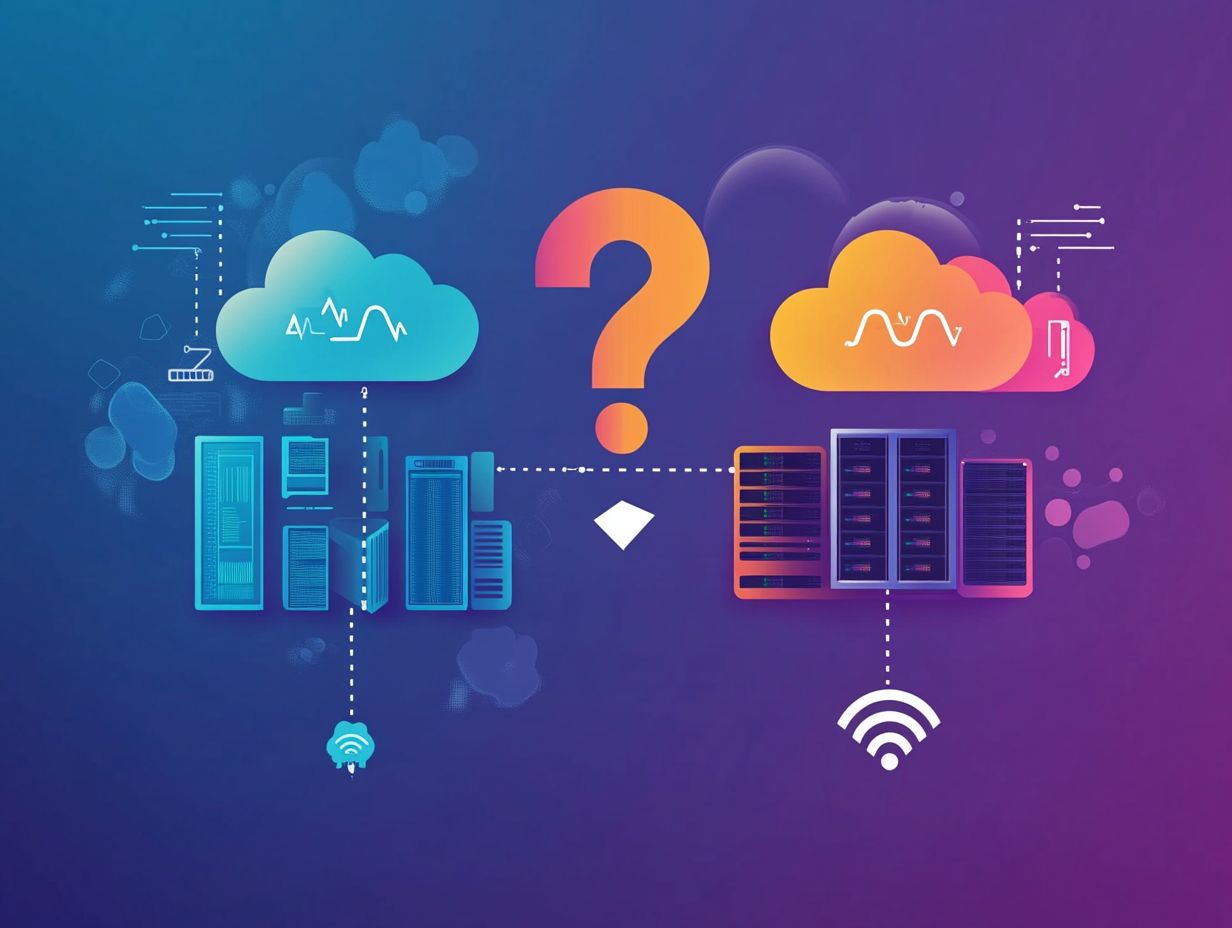PaaS vs IaaS: What’s the Difference?
In today s rapidly evolving tech landscape, grasping cloud computing models is essential for you as a business leader seeking to optimize your operations.
This article delves into two pivotal models Platform as a Service (PaaS) and Infrastructure as a Service (IaaS) unpacking their definitions, core concepts, and key distinctions.
You ll uncover the benefits and limitations of each model, along with crucial factors to consider when deciding between them. Real-world examples will bring their practical applications to life, ensuring you have a clear understanding.
Get ready to unlock the secrets of PaaS and IaaS. Discover the best option for your business needs today!
Contents
- Key Takeaways:
- Understanding PaaS and IaaS
- Key Differences Between PaaS and IaaS
- Benefits and Limitations of PaaS
- Benefits and Limitations of IaaS
- Choosing Between PaaS and IaaS
- Real-World Examples of PaaS and IaaS
- Case Studies and Use Cases
- Frequently Asked Questions
- What is the main difference between PaaS and IaaS?
- How do PaaS and IaaS differ in terms of scalability?
- What is the cost difference between PaaS and IaaS?
- Is PaaS or IaaS better for startups and smaller businesses?
- In what situations would it be more beneficial to use PaaS over IaaS or vice versa?
- Can PaaS and IaaS be used together?
Key Takeaways:
- PaaS focuses on application development platforms.
- IaaS provides online resources.
- Consider scalability, control, and budget when choosing.

Understanding PaaS and IaaS
Platform as a Service (PaaS) and Infrastructure as a Service (IaaS) are essential elements of cloud computing that are transforming the way you deploy and manage applications and infrastructure.
With PaaS, you gain a framework that allows you to build and deploy applications without the hassle of dealing with the underlying hardware or software layers. For more insight, check out understanding PaaS: key features and benefits. On the other hand, IaaS provides you with online resources, enabling you to scale your infrastructure needs with remarkable efficiency.
These service models demonstrate how cloud computing advancements can boost your organization s efficiency and improve customer satisfaction.
Definitions and Basic Concepts
PaaS, or Platform as a Service, gives you the power to develop applications without getting bogged down by the complexities of managing the underlying infrastructure. IaaS, or Infrastructure as a Service, offers virtualized computing resources that you can scale dynamically as your needs change.
These models have transformed the way organizations tackle software development and IT resource management, allowing you to concentrate more on innovation and less on maintenance.
PaaS provides a comprehensive environment filled with tools and libraries. This enhances the development process and fosters collaboration among your teams.
IaaS is cost-effective and flexible, making it ideal for businesses that require rapid data processing and storage capabilities.
Both models have advanced significantly, thanks to innovations in cloud computing technologies, enabling platforms like Google App Engine for PaaS and Amazon Web Services for IaaS to deliver high-performance, scalable services tailored to your diverse business needs.
Key Differences Between PaaS and IaaS
Grasping the key differences between Platform as a Service (PaaS) and Infrastructure as a Service (IaaS) is crucial for you as a business looking to maximize the benefits of SaaS vs. PaaS in cloud computing.
PaaS provides a robust platform for application development, empowering developers to create and deploy applications without the hassle of managing the underlying hardware.
On the other hand, IaaS offers online resources, allowing you to run entire operating systems and applications in a scalable way.
This distinction influences not only how you integrate software solutions but also affects licensing models and your overall control over computing resources.
Infrastructure vs Platform
The primary distinction between IaaS and PaaS revolves around control over your computing environment. IaaS offers virtual machines and storage solutions, while PaaS provides a development platform for application creation.
This difference has significant implications for user experience, flexibility, and control. If you’re part of a strong IT team, you might prefer IaaS for detailed control over your infrastructure. This allows tailored configurations that match your operational needs, which is especially beneficial for hosting older applications or managing complex workloads.
On the other hand, if your goal is to simplify development processes, PaaS could be ideal for you. It enables rapid deployment without the hassle of managing underlying infrastructure. For instance, a startup launching a mobile app might find PaaS appealing. It allows them to focus on app development while using the platform s pre-built tools.
Ultimately, your choice between IaaS and PaaS will depend on finding the right balance of control and convenience that suits your project requirements.
Usage and Implementation

The usage and implementation of IaaS and PaaS can significantly enhance your organization’s capacity for application development. These cloud services are tailored to your specific needs, boosting operational efficiency.
By offering flexible, on-demand resources in a scalable environment, these services empower you to innovate faster and adapt to market changes seamlessly.
For example, if you’re developing complex applications, you might turn to PaaS platforms to streamline your workflow. They integrate development tools and deployment support that can reduce your time to market dramatically.
Similarly, IaaS helps you manage large data environments and computing power without heavy investments in physical infrastructure.
Selecting the right service is crucial for maintaining security and data integrity. Ensuring a smooth transition that complements your existing systems is essential.
Benefits and Limitations of PaaS
Platform as a Service (PaaS) offers many advantages for your organization. It accelerates application development and deployment.
PaaS enhances your control over development environments. It allows seamless scalability of applications and boosts customer engagement through timely updates and collaboration tools.
However, watch out for some challenges that come with PaaS. Security risks and integration issues can arise, making careful planning essential to fully leverage PaaS benefits.
Pros and Cons of Using PaaS
You should weigh the pros and cons of using Platform as a Service (PaaS) to see how it fits into your application development strategy.
If you want to streamline development processes, PaaS can offer significant benefits. It provides enhanced operational efficiency and reduces time-to-market for your applications.
Platforms like Heroku and Google App Engine illustrate these benefits by providing robust environments where you can easily deploy and manage applications without stressing over infrastructure.
However, keep in mind that PaaS comes with challenges. You may face limited control over the underlying infrastructure and potential data management issues, especially regarding compliance and security.
As you evaluate how PaaS aligns with your goals and IT landscape, these factors should definitely be considered.
Benefits and Limitations of IaaS
Infrastructure as a Service (IaaS) offers remarkable advantages, including flexibility, cost savings, and scalability. However, it also presents unique challenges that you must navigate.
This model gives you the power to manage your computing infrastructure more efficiently. By leveraging virtual machines and remote servers, you enhance your operational effectiveness.
That said, carefully consider security risks and data management issues, as these can complicate the implementation process.
Pros and Cons of Using IaaS
Evaluar los pros y los contras de la Infraestructura como Servicio (IaaS) es esencial para cualquier organizaci n que considere este modelo de computaci n en la nube. IaaS puede optimizar tu eficiencia operativa y almacenamiento de datos.
Comprender c mo IaaS puede mejorar tu productividad y los desaf os de gesti n que presenta es crucial. Uno de los principales beneficios es su rentabilidad, ya que solo pagas por los recursos que utilizas.
Su escalabilidad te permite ajustar f cilmente tus recursos seg n las demandas. Esto es ideal para startups que necesitan aumentar recursos r pidamente sin la carga de mantener hardware.
Sin embargo, debes considerar las preocupaciones de seguridad y la gesti n de recursos en la nube, que pueden ser dif ciles para equipos m s peque os. Aprende de empresas como Dropbox, que han utilizado IaaS efectivamente mientras implementan protocolos de seguridad robustos.
Choosing Between PaaS and IaaS

Cuando decidas entre Platform as a Service (PaaS) e Infrastructure as a Service (IaaS), es esencial comprender varios factores clave. Eval a tus necesidades espec ficas en desarrollo de aplicaciones y eficiencia operativa.
Considera tu infraestructura existente y los riesgos de seguridad asociados a cada modelo. Tu elecci n depender del control que desees mantener y las cargas de trabajo que necesites manejar eficientemente.
Factors to Consider
Al ponderar tus opciones entre PaaS e IaaS, considera factores cr ticos que alineen tu elecci n con los objetivos estrat gicos de tu organizaci n. Piensa en la flexibilidad necesaria en el desarrollo de aplicaciones y el costo de los recursos en la nube.
Por ejemplo, PaaS ofrece gran flexibilidad, permitiendo a los desarrolladores centrarse en programar en lugar de gestionar infraestructura. IaaS, en cambio, brinda mayor control, siendo atractivo para empresas con requisitos de cumplimiento estrictos.
El costo tambi n juega un papel crucial. Aunque las soluciones PaaS pueden parecer m s caras al principio, a menudo reducen el tiempo de desarrollo y los costos, especialmente para startups. Comprender estas diferencias te ayudar a encontrar la mejor soluci n.
Real-World Examples of PaaS and IaaS
Ejemplos reales de PaaS e IaaS ofrecen perspectivas valiosas sobre c mo las organizaciones utilizan estos modelos de computaci n en la nube. Empresas como Salesforce y Adobe Creative Cloud han utilizado plataformas PaaS para optimizar sus procesos de aplicaci n.
IBM Cloud y Google Cloud muestran las ventajas significativas de IaaS en la gesti n eficiente de recursos inform ticos. Al analizar estos estudios de caso, puedes aprender las mejores pr cticas para implementar en diversas industrias.
Case Studies and Use Cases
Case studies and use cases of PaaS and IaaS illustrate the diverse applications of these cloud models. They offer significant benefits to organizations across various sectors.
Consider a prominent financial institution that struggled with significant challenges in scaling its infrastructure to meet fluctuating customer demands. By embracing IaaS, they were able to provision resources on-the-fly, effectively slashing downtime during peak periods.
On the retail front, a leading brand harnessed PaaS to streamline its application development process. This transition led to a remarkable 30% increase in deployment speed and a substantial boost in overall operational efficiency.
Each successful implementation tackled immediate organizational pain points and set the stage for future innovations. This showcases the transformative potential of these cloud solutions.
Frequently Asked Questions
What is the main difference between PaaS and IaaS?

PaaS, or Platform as a Service, provides tools for building applications, and understanding the differences between PaaS and SaaS is crucial. For a deeper insight, check out PaaS vs SaaS: which is right for you? IaaS, or Infrastructure as a Service, offers virtual servers and storage resources for businesses to manage their computing needs.
How do PaaS and IaaS differ in terms of scalability?
PaaS is typically more scalable than IaaS. It provides pre-configured resources and tools for developers to rapidly deploy and scale applications. IaaS offers more flexibility in customizing server resources but requires more technical expertise and effort to scale.
What is the cost difference between PaaS and IaaS?
PaaS tends to have a higher cost compared to IaaS, as it includes infrastructure, platform, and tools for application development. IaaS offers a pay-as-you-go model, allowing businesses to pay only for the resources they use.
Is PaaS or IaaS better for startups and smaller businesses?
Startups and smaller businesses often thrive with PaaS, allowing them to innovate without the hassle of managing infrastructure. IaaS may require more technical expertise and resources, which can be a challenge for smaller businesses with limited budgets.
In what situations would it be more beneficial to use PaaS over IaaS or vice versa?
PaaS is typically more suitable for businesses focused on application development and deployment. In contrast, IaaS is better for businesses that require more control and flexibility in managing their infrastructure. For example, a software development company may benefit more from PaaS, while a data-driven company may prefer IaaS.
Can PaaS and IaaS be used together?
Absolutely! Many businesses use a combination of PaaS and IaaS to take advantage of both platforms. For instance, a company may use PaaS for developing and deploying applications while using IaaS to manage databases and storage. This combination allows for a more comprehensive and efficient approach to managing platform and infrastructure needs.






